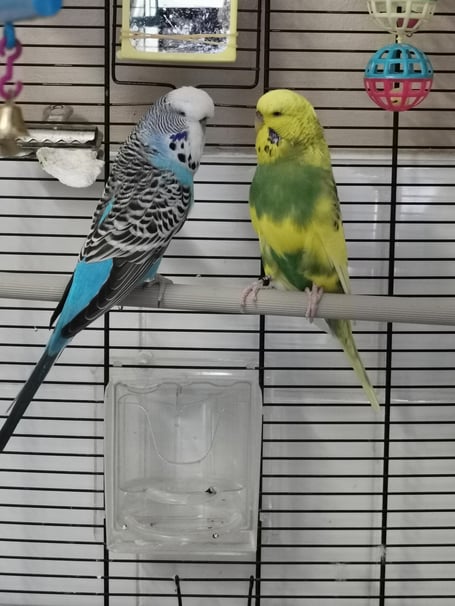Meet Harriet and Kiwi – budgies who were brought to us for rehoming because they never stop chatting and their previous owner couldn’t tolerate the noise!
They have now been rehomed – in fact, we could have rehomed them several times over because there is a high demand for these little birds even though they are not as ‘fashionable’ as they once were.
The captive budgerigar, to give the species its correct name (from the native Australian betcherrygah, translated as ‘good parakeet’), has an interesting history.
The first pair was brought from Australia to England in 1840 by an enthusiast called John Gould who described them as ‘the most animated, cheerful little creatures you can possibly imagine’.
He also said that they were good to eat – indeed, they were considered a delicacy by native Australians.
Budgies then became very common in the aviaries of Europe, and Queen Victoria was given a pair in 1845.
Twenty years later budgies were being imported in barely sustainable quantities, with virtually every ship sailing from South Australia to Europe containing hundreds of them in its cargo.
By 1894 the Australian authorities became so alarmed at the depletion of native stocks that exports were banned. By this time budgies were being successfully bred in Europe, with America following suit in the 1950s.
Budgies may be a relatively recent addition as pets in the western world, but they have existed for several million years in Australia.
They are members of the parrot family which has been around for at least 23 million years, and they are the smallest member of the genus, growing up to 18cm long in the wild, and 24cm in captivity.
Parrots are the most intelligent members of the bird family, although crows come a very close second.
The part of their brain that is able to learn and memorise sounds, including human speech, is very well developed.
The budgie Guinness World Record holder for speech had an amazing 1,728 words in his vocabulary.
There is only one species of budgie, and breeders classify their birds according to colour and variety rather than breed.
The colours that distinguish the two broad groupings of budgie are green/yellow and blue/white, with the ancestral wild budgie being a lemon-and-lime hue.
There are now more than 30 colour combinations, but you will never find a red budgie.
If a budgie’s plumage changes colour after it has reached adulthood it is usually a sign of dietary deficiency.
Another cause may be a lack of cleanliness – if a budgie doesn’t preen itself regularly its feathers will look faded. Budgies like to bathe in water and so a bird bath with fresh, clean water should always be provided.
Other basic requirements for a happy budgie are:
*A large, well designed cage or aviary that can be kept in a warm room and be cleaned daily
*A well-balanced and varied diet that includes seeds, fruit, greens and minerals
*A stress-free environment (no cats, no inquisitive young children, and no all-night lights)
*The company of another budgie, because they are such social creatures
*A smoke-free, low-noise environment
*The space to fly.
A well cared-for captive budgie can live for up to 15 years, although most will live until they are about eight years old.
A bird called Charlie is the record holder – he died in 1977 having lived to the grand old age of 29 years and two months.


.jpeg?width=209&height=140&crop=209:145,smart&quality=75)
.jpeg?width=209&height=140&crop=209:145,smart&quality=75)

Comments
This article has no comments yet. Be the first to leave a comment.